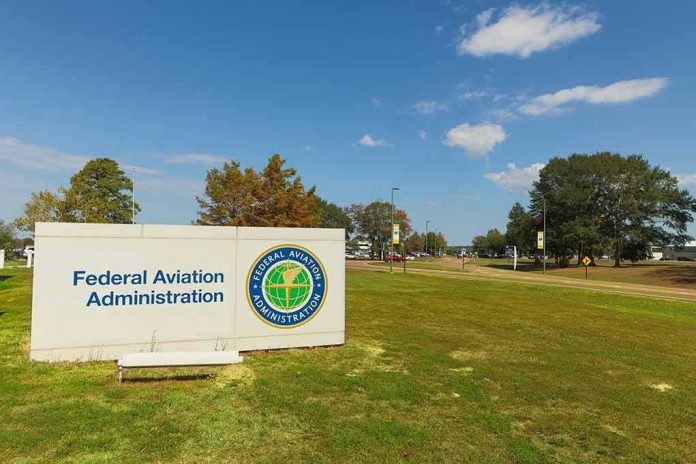
The Department of Transportation’s Inspector General is now investigating why the FAA quietly shifted Newark’s air traffic control to Philadelphia, a move that’s left the nation’s busiest air corridor vulnerable to alarming blackouts and puts public safety on the line.
At a Glance
- DOT Inspector General launches audit into FAA’s decision to move Newark air traffic control to Philadelphia.
- Two major blackouts in spring 2025 left controllers unable to communicate with planes for 90 seconds each time.
- Airlines, passengers, and local communities are demanding answers about safety and reliability.
- The FAA’s move, designed to address chronic understaffing, may have created bigger risks than it solved.
DOT Inspector General Demands Answers on Newark Air Traffic Relocation
After a cascade of failures and two chilling radio blackouts, the Department of Transportation’s Inspector General has announced an official audit into the FAA’s controversial decision to transfer Newark Liberty International Airport’s air traffic control operations from New York to Philadelphia. The Inspector General’s office is responding to mounting pressure from airlines, air traffic controllers, and everyday Americans who are rightly concerned about the chaos that could result from such a move in the nation’s most congested airspace.
The Department of Transportation's Inspector General's Office will conduct an audit concerning the move of the Newark Air Traffic control to Philadelphia in the aftermath of multiple blackouts this year. https://t.co/RNO8SQDneA
— NEWSMAX (@NEWSMAX) July 28, 2025
The FAA, under fire for its handling of chronic understaffing and aging infrastructure in New York’s TRACON, gambled big last year by relocating Newark’s control operations. They claimed this would modernize air traffic management and fix staffing woes. Instead, it has triggered fresh operational disruptions, including two separate 90-second outages in April and May 2025—leaving controllers blind and silent in one of the world’s busiest flight corridors. The DOT Inspector General’s audit, set to begin in August, will scrutinize whether the FAA’s risk assessments and planning were up to snuff, and whether the agency put expediency ahead of public safety and common sense.
Failures Expose Dangers of Rushed Bureaucratic Fixes
The FAA’s decision didn’t come out of nowhere. Newark, one of the busiest airports in the country, has battled persistent issues at New York’s air traffic control center: not enough controllers, outdated technology, and more flights than ever before. In July 2024, the FAA shifted Newark’s TRACON responsibilities to Philadelphia, gambling that newer facilities and fresh staff could patch over deep cracks in the system. Instead, the move set the stage for disaster. In April, a burnt copper wire triggered a blackout, and just weeks later, redundant systems failed—leaving pilots and controllers unable to communicate or track aircraft for a harrowing minute and a half each time. The scale of these outages is unprecedented for a major U.S. airport, and exposes the high cost of bureaucratic band-aid solutions that ignore the realities on the ground.
Airlines like United, Delta, JetBlue, and American are left holding the bag, dealing with delays, cancellations, and angry passengers. Communities near Newark and Philadelphia are seeing their lives disrupted, while air traffic controllers are stretched thin and working in unfamiliar territory. The FAA’s assurances that new fiber optic communications will fix everything ring hollow given the magnitude of recent failures. These aren’t the growing pains of modernization—they’re the warning signs of a system at breaking point, made worse by rushed decisions and questionable priorities.
Audit Could Force FAA to Reverse Course or Reform
The DOT Inspector General’s audit will go beyond the technical failures. Investigators will examine whether the FAA properly assessed the risks, adequately consulted with the National Air Traffic Controllers Association, and fully considered the operational and safety impacts before making such a consequential shift. The audit will also look at how delays, cancellations, and passenger safety have been affected since the move. If the findings show that the FAA cut corners or failed to live up to its mandate, it could force the agency to reconsider the relocation or make major infrastructure investments. This is more than a bureaucratic slap on the wrist—it’s a potential turning point for how the nation manages its air traffic in the Northeast and beyond.
Ordinary Americans—especially those who still believe in common sense, accountability, and the rule of law—are fed up with agencies making sweeping decisions with little transparency and even less regard for real-world consequences. The political class might be content to let unelected officials treat our airspace as their personal experiment, but the public deserves better. As the audit moves forward, all eyes are on whether the FAA will finally be held to account—or whether the cycle of government overreach, botched priorities, and avoidable crises will continue unchecked.
Expert Voices Warn of Broader Risks and Call for Real Reform
Aviation experts agree: consolidating air traffic control might make sense on paper, but in practice, it’s a risky move unless backed by robust redundancy, proper training, and real accountability. The National Air Traffic Controllers Association has been vocal about the need for fully staffed crews and modern equipment—not just at Newark, but across the entire national airspace system. Industry analysts point out that the FAA’s rush to relocate control functions could be a harbinger of similar moves elsewhere, setting a dangerous precedent for how government agencies tackle complex problems.
Americans are tired of seeing government bureaucrats gamble with public safety while ignoring the voices of frontline workers and the concerns of everyday citizens. The DOT Inspector General’s audit is a critical step, but it’s only the beginning. Unless the FAA and other agencies return to basics—transparent decision-making, real risk assessment, and a commitment to public safety—these fiascos will keep repeating. The time for accountability is now, before another blackout or bureaucratic misfire puts lives at risk.
Sources:
Central Jersey Transportation: FAA plans to move air traffic control to Philadelphia
Newsmax: DOT to Audit Newark’s Air Traffic Control Move
Bloomberg: Watchdog Probing Relocation of Newark Air Traffic Control
FAA: Statements on Newark Liberty International Airport
KBOI: DOT to Audit Newark’s Air Traffic Control Move to Philly













